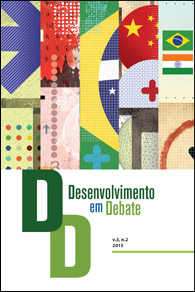A desaceleração chinesa e o “Novo Normal”: implicações estruturais para a economia e o setor financeiro doméstico
Palavras-chave:
China, Novo Normal, Instituições, Sistema Financeiro, Desenvolvimento EconômicoResumo
Após décadas de crescimento econômico robusto, facultando crescente proeminência geopolítica no sistema interestatal capitalista, a China dá sinais de desaceleração em meio a profundas mudanças e incertezas em seu regime produtivo. Conformea estratégia de desenvolvimento prévia, com forte participação dos investimentos e do desempenho exportador, parece esgotar-se, um novo cenário se desenha, com distintas oportunidades e riscos. Assim, mediante dados empíricos e literatura pertinente, este trabalho fará uma reflexão conjuntural sobre o paradigma do “Novo Normal” e seus desdobramentos para a trajetória futura da potência asiática, problematizando possíveis transformações na interlocução entre instituições de Estado e de mercado, principalmente no setor financeiro.
Referências
AGLIETTA, M.; GUO, B. China’s Development: Capitalism and Empire. London: Routledge, 2013.
AMSDEN, A. et al. “China’s Macroeconomy, Environment, and Alternative Transition Model”.
World Development, Vol.24, N.2, 1996. pp.273-286.
ANDERSON, J. “Is China Export-Led?”. UBS Investment Research - Asian Focus, 2007. pp.1-12.
EDMONDS, C. et al. “China’s rise as a trading power”. IN.: McNALLY, Christopher. China’s Emergent Political Economy: Capitalism in the Dragon’s Lair. London: Routledge, 2008. pp.169-189.
EL-ERIAN, M. “The Chinese Economy’s Great Wall”. Project Syndicate, 2016. Disponível em: < https://www.project-syndicate.org/commentary/chinese-growth-slowdown-global-economic- turmoil-by-mohamed-a--el-erian-2016-01> Acesso em 13 de fevereiro de 2016.
GAO, X. “State-owned enterprises in China: How big are they?”. World Bank, 2010. Disponível em:
< http://blogs.worldbank.org/eastasiapacific/state-owned-enterprises-in-china-how-big-are- they >Acesso em 27 de janeiro de 2016.
GLOSNY, M. “Stabilizing the backyard: recent developments in China’s policy towards Southeast Asia”. IN: EISENMAN, J. et al (eds.) China and the Developing World:
Beijing’s Strategy for the Twenty-First Century. London: East Gate Books, 2007. p.150-186.
HONG, W. et al. “China’s 13th Five-Year Plan (2016-2020): Redefining China’s development paradigm under the new normal”. China’s Policy Think Piece Series Issue No.2. Dezembro de 2015. pp.1-25.
HU, A. “Embracing China’s New Normal: When the Economy Is Still on Track”. Foreign Affairs, Vol.94, N.3, 2015.
HUNG, H. “A Caveat: Is the Rise of China Sustainable?”. IN.: HUNG, Ho-Fung (ed.). China and the Transformation of Global Capitalism. Baltimore: The Johns Hopkins University Press, 2009. pp.188-202.
JAGUARIBE, A. “China: estratégias de modernização alternativa”. Desenvolvimento em Debate, v.2, n.2, 2011. pp.39-49.
McNALLY, C. China’s Emergent Political Economy: Capitalism in the Dragon’s Lair. London: Routledge, 2008.
____. “The evolution and contemporary manifestations of Sino-capitalism”. IN: BECKER, Uwe. The Brics and emerging economies in comparative perspective: political economy, liberalization and institutional change. London: Routledge, 2014. pp.53-78.
MEDEIROS, C. “Economia e Política do Desenvolvimento Recente na China”. Revista de Economia Política, vol.19, n.3 (75), julho-setembro, 1999. pp.93-112.
____. “O Ciclo Recente de Desenvolvimento Chinês e seus Desafios”. Observatório de Economia Global, N.3, 2010. pp.1-23.
NATIONAL BUREAU OF STATISTICS. China Statistical Yearbook 2009. Disponível em: < http:// www.stats.gov.cn/tjsj/ndsj/2009/indexeh.htm >.
____. China Statistical Yearbook 2012. Disponível em: < http://www.stats.gov.cn/tjsj/ ndsj/2012/indexeh.htm >.
____. China Statistical Yearbook 2014. Disponível em: < http://www.stats.gov.cn/tjsj/ ndsj/2014/indexeh.htm >.
____. China Statistical Yearbook 2015. Disponível em: < http://www.stats.gov.cn/tjsj/ ndsj/2015/indexeh.htm >.
NAUGHTON, B. Growing Out of the Plan: Chinese Economic Reform, 1978-1993. Cambridge University Press, 1995.
____. The Chinese Economy: Transitions and Growth. Cambridge: The MIT Press, 2007.
NOGUEIRA, I. Desenvolvimento Econômico, Distribuição de Renda e Pobreza na China Contemporânea. Tese de Doutorado. IE-UFRJ, 2011.
ROACH, S. “False Alarm on China”. Project Syndicate, 2016. Disponível em < https://www.project- syndicate.org/commentary/china-crisis-false-alarm-by-stephen-s--roach-2016-01 >. Acesso em 9 de fevereiro de 2016.
RODRIK, D. The Globalization Paradox: Democracy and the Future of the World Economy. London:
W. W. Norton, 2011.
SAICH, T. The Governance and Politics of China. 4.ed. London: Palgrave Macmillan, 2015.
SCHMIDT, D. “The Financial Crisis and Its Impact on China”. China Analysis 67, Janeiro de 2009. pp.1-4.
STIGLITZ, J. “China’s bumpy new normal”. Nikkei Asian Review, 2016. Disponível em: < http:// asia.nikkei.com/Viewpoints/Viewpoints/China-s-bumpy-new-normal?page=1 >. Acesso em 28/01/2016.
THE PEOPLE’S BANK OF CHINA. Annual Report. Vários anos. Disponível em: < http://www.pbc. gov.cn/english/130739/index.html >. Acessado em 25 de janeiro de 2016.
TRADING ECONOMICS. Trading Economics Database. Disponível em: < http://www. tradingeconomics.com/ >. Acessado em 25 de janeiro de 2016.
VERMEIREN, M.; DIERCKX, S. “Challenging Global Neoliberalism? The global political economy of China’s capital controls”. Third World Quarterly. 33:9, 2012. pp.1647-1668.
WANG, Y. “The rise of the ‘shareholding state’: financialization of economic management in China”. Socio-Economic Review. Vol 13, No.3, 2015. pp.603-625.
WEI, S. “China’s Slowdown and Asia’s Economy”. Project Syndicate, 2016. Disponível em: < http:// www.project-syndicate.org/commentary/china-slowdown-asian-economy-by-shang-jin-
wei-2016-01 > Acessado em 24 de janeiro de 2016.
WORLD BANK. World Development Indicators. Disponível em: < http://data.worldbank.org/data- catalog/world-development-indicators >.
YANG, L.; HUIZENGA, C. “China’s Economy in the Global Economic Crisis: Impact and Policy Responses”. In.: UNCTAD. The Financial and Economic Crisis of 2008-2009 and Developing Countries. New York: United Nations, 2010. Disponível em: < http://unctad.org/en/Docs/ gdsmdp20101_en.pdf >. pp.119-148.

